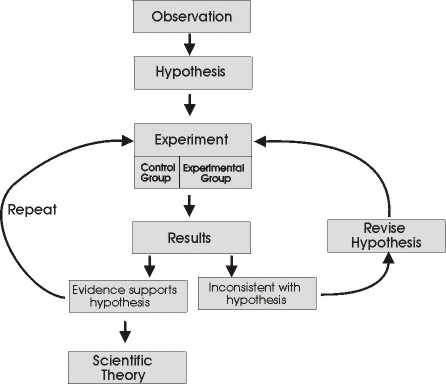| The Scientific Process | |
 Scientists make progress by using the scientific method, a process of checking conclusions against nature. After observing something, a scientist tries to explain what has been seen. Scientists make progress by using the scientific method, a process of checking conclusions against nature. After observing something, a scientist tries to explain what has been seen.
The explanation of an observation is called a hypothesis. There is always at least one alternative hypothesis. The alternative hypothesis suggests that a specific factor causes a result. The null hypothesis (no effect, no influence) assumes that the factor is not responsible for the observation. A part of nature is tested in a "controlled experiment" to see if a hypothetical explanation is consistent with reality. A controlled experiment is one in which all treatments are identical except that some are exposed to a hypothetical factor and some are not. Any differences in the way the treatments behave is attributed to the presence or lack of the factor. If the results of the experiment do not provide sufficient information to show that the hypothetical factor causes the result predicted, then the null hypothesis cannot be rejected. The explanation in the null hypothesis continues to provide our best description of what we observed. Of course, the scientist may redesign the experiment to test the null hypothesis against another alternative. When enough evidence accumulates, the understanding of this natural phenomenon is considered a scientific theory. A scientific theory persists until additional evidence causes it to be revised. A scientific theory is a testable model, based on fact, of a natural phenomenon. It is capable of predicting future occurrences or observations of the same kind, and capable of being tested through experiment or otherwise verified through empirical observation. In everyday language a theory means a hunch or speculation. In science, the word theory means a comprehensive explanation of an important feature of nature that is supported by many facts gathered over time. Nature's reality is always the final judge of a scientific theory. | |
| Citation: Theory | |